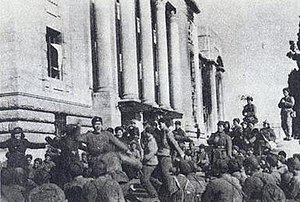Third Battle of Seoul
| Third Battle of Seoul | |||||||
|---|---|---|---|---|---|---|---|
| Part of the Korean War | |||||||
 Chinese troops celebrate the capture of Seoul. |
|||||||
|
|||||||
| Belligerents | |||||||
|
|
|||||||
| Commanders and leaders | |||||||
|
|
|
||||||
| Units involved | |||||||
|
|||||||
| Strength | |||||||
|
US: 136,525 Commonwealth: 12,269 South Korea: Unknown |
~170,000 | ||||||
| Casualties and losses | |||||||
|
Australia: 9 South Korea: Unknown UK: 300 US: 481 Chinese estimation: 19,000 |
China: ~5,800 North Korea: ~2,700 |
||||||
Coordinates: 37°34′08″N 126°58′36″E / 37.56889°N 126.97667°E
The Third Battle of Seoul, also known as the Chinese New Year's Offensive, the January–Fourth Retreat (Korean: 1•4 후퇴) or the Third Phase Campaign Western Sector (Chinese: 第三次战役西线; pinyin: Dì Sān Cì Zhàn Yì Xī Xiàn), was a battle of the Korean War, which took place from December 31, 1950 to January 7, 1951 around the South Korean capital of Seoul. In the aftermath of the major Chinese victory at the Battle of the Ch'ongch'on River, the United Nations Command started to contemplate the possibility of evacuation from the Korean Peninsula. Upon learning of this development, China's Chairman Mao Zedong ordered the Chinese People's Volunteer Army to cross the 38th parallel in an effort to pressure the United Nations forces to withdraw from South Korea.
...
Wikipedia
